Page 290 of 417
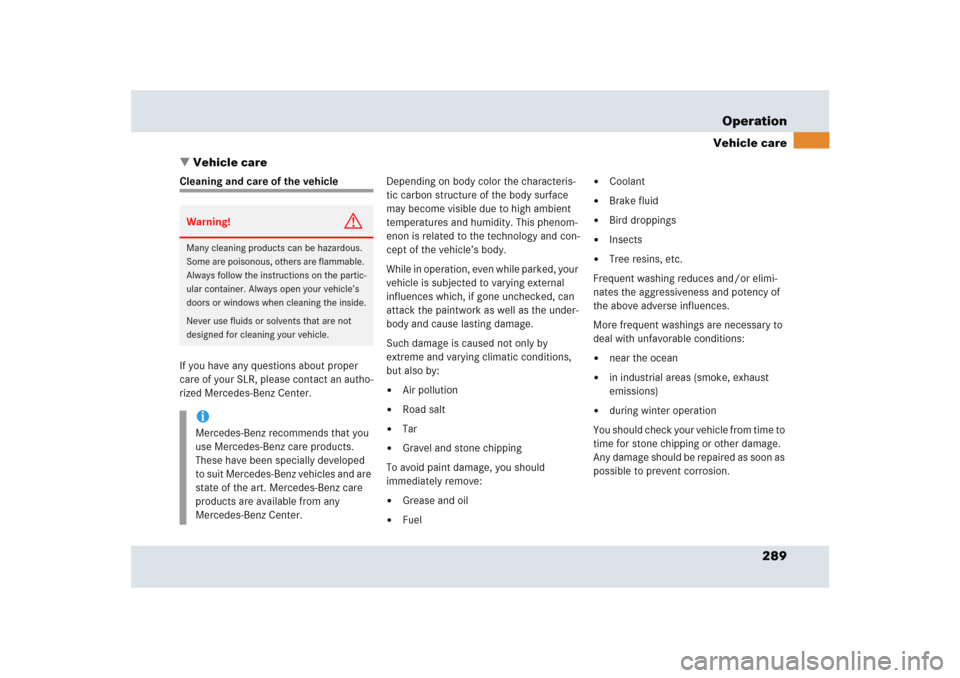
289 Operation
Vehicle care
�Vehicle care
Cleaning and care of the vehicle
If you have any questions about proper
care of your SLR, please contact an autho-
rized Mercedes-Benz Center.Depending on body color the characteris-
tic carbon structure of the body surface
may become visible due to high ambient
temperatures and humidity. This phenom-
enon is related to the technology and con-
cept of the vehicle’s body.
While in operation, even while parked, your
vehicle is subjected to varying external
influences which, if gone unchecked, can
attack the paintwork as well as the under-
body and cause lasting damage.
Such damage is caused not only by
extreme and varying climatic conditions,
but also by:
�
Air pollution
�
Road salt
�
Tar
�
Gravel and stone chipping
To avoid paint damage, you should
immediately remove:
�
Grease and oil
�
Fuel
�
Coolant
�
Brake fluid
�
Bird droppings
�
Insects
�
Tree resins, etc.
Frequent washing reduces and/or elimi-
nates the aggressiveness and potency of
the above adverse influences.
More frequent washings are necessary to
deal with unfavorable conditions:
�
near the ocean
�
in industrial areas (smoke, exhaust
emissions)
�
during winter operation
You should check your vehicle from time to
time for stone chipping or other damage.
Any damage should be repaired as soon as
possible to prevent corrosion.
Warning!
G
Many cleaning products can be hazardous.
Some are poisonous, others are flammable.
Always follow the instructions on the partic-
ular container. Always open your vehicle’s
doors or windows when cleaning the inside.
Never use fluids or solvents that are not
designed for cleaning your vehicle.iMercedes-Benz recommends that you
use Mercedes-Benz care products.
These have been specially developed
to suit Mercedes-Benz vehicles and are
state of the art. Mercedes-Benz care
products are available from any
Mercedes-Benz Center.
Page 300 of 417
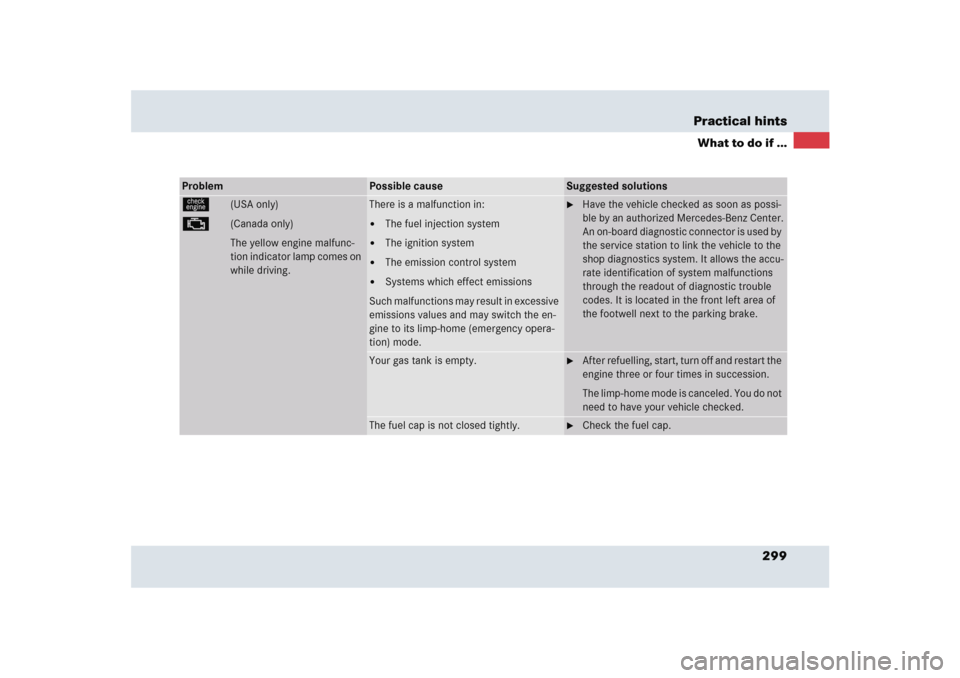
299 Practical hints
What to do if ...
Problem
Possible cause
Suggested solutions
ú
(USA only)
±
(Canada only)
The yellow engine malfunc-
tion indicator lamp comes on
while driving.
There is a malfunction in:�
The fuel injection system
�
The ignition system
�
The emission control system
�
Systems which effect emissions
Such malfunctions may result in excessive
emissions values and may switch the en-
gine to its limp-home (emergency opera-
tion) mode.
�
Have the vehicle checked as soon as possi-
ble by an authorized Mercedes-Benz Center.
An on-board diagnostic connector is used by
the service station to link the vehicle to the
shop diagnostics system. It allows the accu-
rate identification of system malfunctions
through the readout of diagnostic trouble
codes. It is located in the front left area of
the footwell next to the parking brake.
Your gas tank is empty.
�
After refuelling, start, turn off and restart the
engine three or four times in succession.
The limp-home mode is canceled. You do not
need to have your vehicle checked.
The fuel cap is not closed tightly.
�
Check the fuel cap.
Page 302 of 417
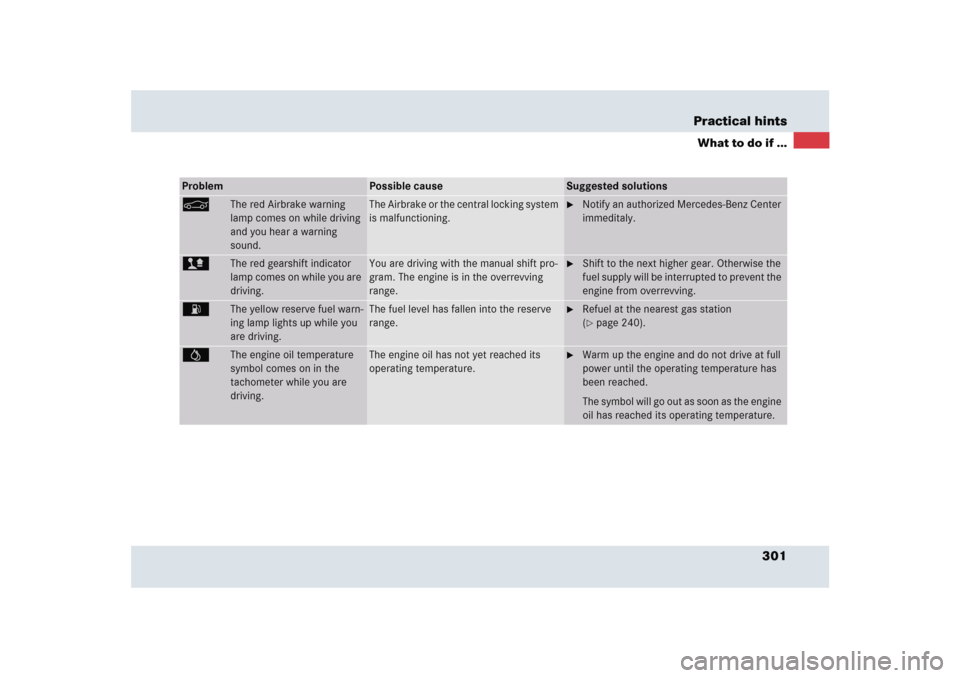
301 Practical hints
What to do if ...
Problem
Possible cause
Suggested solutions
<
The red Airbrake warning
lamp comes on while driving
and you hear a warning
sound.
The Airbrake or the central locking system
is malfunctioning.
�
Notify an authorized Mercedes-Benz Center
immeditaly.
>
The red gearshift indicator
lamp comes on while you are
driving.
You are driving with the manual shift pro-
gram. The engine is in the overrevving
range.
�
Shift to the next higher gear. Otherwise the
fuel supply will be interrupted to prevent the
engine from overrevving.
A
The yellow reserve fuel warn-
ing lamp lights up while you
are driving.
The fuel level has fallen into the reserve
range.
�
Refuel at the nearest gas station
(�page 240).
=
The engine oil temperature
symbol comes on in the
tachometer while you are
driving.
The engine oil has not yet reached its
operating temperature.
�
Warm up the engine and do not drive at full
power until the operating temperature has
been reached.
The symbol will go out as soon as the engine
oil has reached its operating temperature.
Page 330 of 417
329 Practical hints
What to do if ...
Left display
Right display
Possible cause
Possible solution
±
Display malfunc-
tion
Visit
workshop!
Certain electronic systems are
unable to relay information to
the control system. The follow-
ing systems may have failed:�
Coolant temperature gauge
�
Tachometer
�
Cruise control display
�
Have the electronic systems checked by an authorized
Mercedes-Benz Center immediately.
Fuel system
malfunction
Visit
workshop!
The fuel cooling system is
malfunctioning.
�
Visit an authorized Mercedes-Benz Center immediately.
Page 340 of 417
339 Practical hints
What to do if ...
Left display
Right display
Possible cause
Possible solution
A
Reserve fuel
The fuel level has fallen into the
reserve range.
�
Refuel at the next gas station (
�page 240).
I
Remove
key!
You have forgotten to remove
the SmartKey.
�
Remove the SmartKey from the starter switch.
Replace
key
No additional code available for
the SmartKey.
�
Have the SmartKey checked. Notify an authorized
Mercedes-Benz Center.
W
Washer fluid
Check level!
The washer fluid level has
dropped to about
1/3 of total
reservoir capacity.
�
Add washer fluid (
�page 251).
N
Close
center compart.
The interior motion sensor is
only activated when the stor-
age compartment under the
armrest is closed.
�
Close the storage compartment under the armrest
(�page 200).
Page 353 of 417
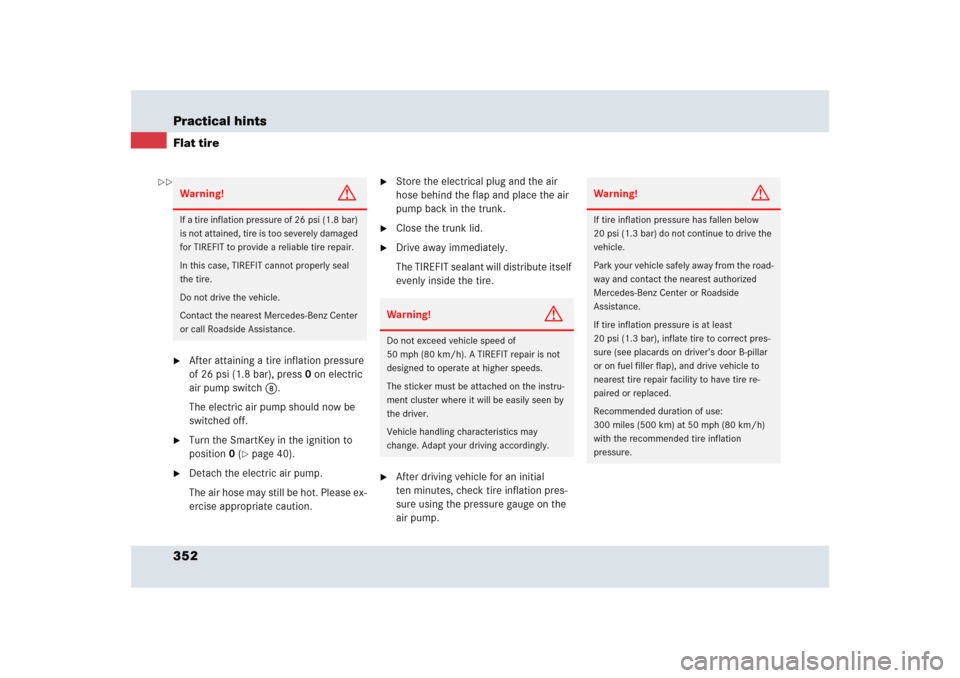
352 Practical hintsFlat tire�
After attaining a tire inflation pressure
of 26 psi (1.8 bar), press0 on electric
air pump switch8.
The electric air pump should now be
switched off.
�
Turn the SmartKey in the ignition to
position0 (
�page 40).
�
Detach the electric air pump.
The air hose may still be hot. Please ex-
ercise appropriate caution.
�
Store the electrical plug and the air
hose behind the flap and place the air
pump back in the trunk.
�
Close the trunk lid.
�
Drive away immediately.
The TIREFIT sealant will distribute itself
evenly inside the tire.
�
After driving vehicle for an initial
ten minutes, check tire inflation pres-
sure using the pressure gauge on the
air pump.
Warning!
G
If a tire inflation pressure of 26 psi (1.8 bar)
is not attained, tire is too severely damaged
for TIREFIT to provide a reliable tire repair.
In this case, TIREFIT cannot properly seal
the tire.
Do not drive the vehicle.
Contact the nearest Mercedes-Benz Center
or call Roadside Assistance.
Warning!
G
Do not exceed vehicle speed of
50 mph (80 km/h). A TIREFIT repair is not
designed to operate at higher speeds.
The sticker must be attached on the instru-
ment cluster where it will be easily seen by
the driver.
Vehicle handling characteristics may
change. Adapt your driving accordingly.
Warning!
G
If tire inflation pressure has fallen below
20 psi (1.3 bar) do not continue to drive the
vehicle.
Park your vehicle safely away from the road-
way and contact the nearest authorized
Mercedes-Benz Center or Roadside
Assistance.
If tire inflation pressure is at least
20 psi (1.3 bar), inflate tire to correct pres-
sure (see placards on driver’s door B-pillar
or on fuel filler flap), and drive vehicle to
nearest tire repair facility to have tire re-
paired or replaced.
Recommended duration of use:
300 miles (500 km) at 50 mph (80 km/h)
with the recommended tire inflation
pressure.
��
Page 354 of 417
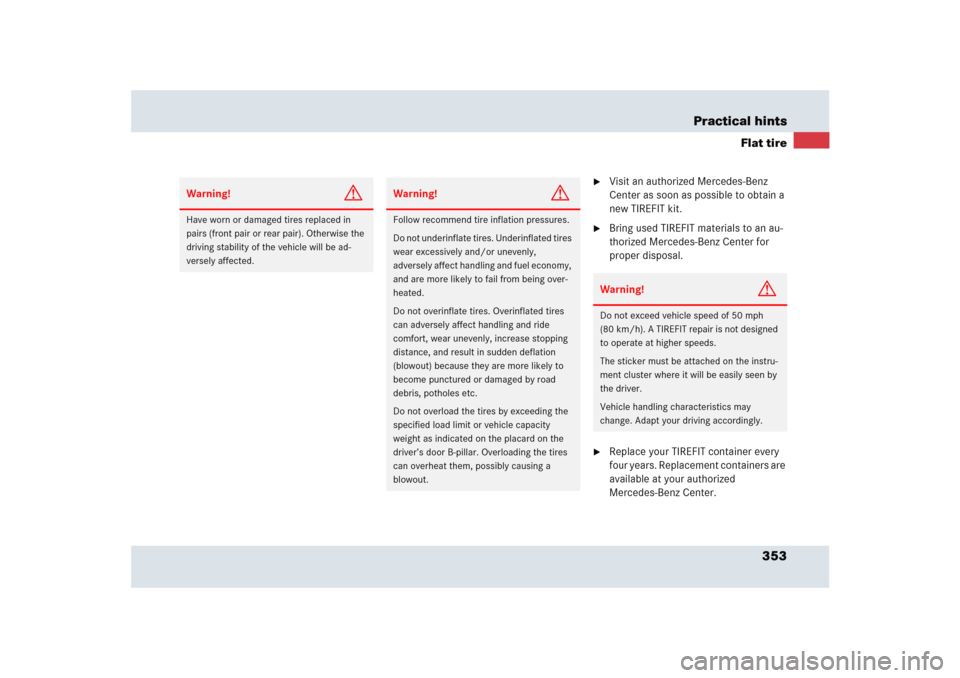
353 Practical hints
Flat tire
�
Visit an authorized Mercedes-Benz
Center as soon as possible to obtain a
new TIREFIT kit.
�
Bring used TIREFIT materials to an au-
thorized Mercedes-Benz Center for
proper disposal.
�
Replace your TIREFIT container every
four years. Replacement containers are
available at your authorized
Mercedes-Benz Center.
Warning!
G
Have worn or damaged tires replaced in
pairs (front pair or rear pair). Otherwise the
driving stability of the vehicle will be ad-
versely affected.
Warning!
G
Follow recommend tire inflation pressures.
Do not underinflate tires. Underinflated tires
wear excessively and/or unevenly,
adversely affect handling and fuel economy,
and are more likely to fail from being over-
heated.
Do not overinflate tires. Overinflated tires
can adversely affect handling and ride
comfort, wear unevenly, increase stopping
distance, and result in sudden deflation
(blowout) because they are more likely to
become punctured or damaged by road
debris, potholes etc.
Do not overload the tires by exceeding the
specified load limit or vehicle capacity
weight as indicated on the placard on the
driver’s door B-pillar. Overloading the tires
can overheat them, possibly causing a
blowout.
Warning!
G
Do not exceed vehicle speed of 50 mph
(80 km/h). A TIREFIT repair is not designed
to operate at higher speeds.
The sticker must be attached on the instru-
ment cluster where it will be easily seen by
the driver.
Vehicle handling characteristics may
change. Adapt your driving accordingly.
Page 363 of 417
Technical dataSpare parts service
Warranty coverage
Identification labels
Layout of poly-V-belt drive
Engine
Rims and tires
Electrical system
Main dimensions
Weights
Fuels, coolants, lubricants, etc.